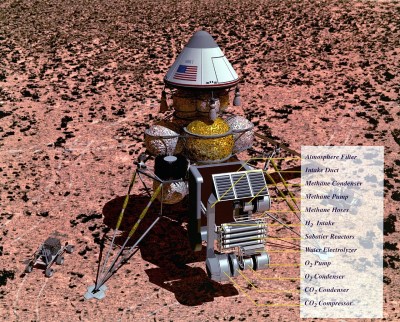
Enlarge / Stratospheric aerosols can make for great sunsets, regardless of how they get there. (credit: Rachel Dulson)
Humanity has managed to stabilize its carbon emissions, but they have yet to start trending downwards. It looks increasingly probable that we're going to emit enough to commit to at least 1.5° C of warming—and we need to act quickly to avert going past 2° C. This failure to get our emissions in order may force us to consider alternatives such as pulling carbon dioxide out of the air or geoengineering to reduce the amount of incoming sunlight.
Of the two, geoengineering comes with the longest list of unknowns, with a recent report from the National Academies of Science saying, "Scientific understanding of many aspects of solar geoengineering technologies remains limited, including how they could affect weather extremes, agriculture, natural ecosystems, or human health."
So, some Silicon Valley types naturally decided to go ahead and launch a startup company that would offer geoengineering for a fee. The company claims to offer warming offsets despite the considerable unknowns regarding geoengineering. And it's even worse than that sounds; based on an article in MIT Technology Review, the company has already started launching balloons to the stratosphere, despite not being capable of determining whether they're actually deploying their payload.

Since NASA’s Mariner spacecraft made the first up-close observations of Mars in 1964, humanity has lobbed a long line of orbiters, landers, and rovers towards the Red Planet. Of course, it hasn’t all been smooth sailing. History, to say nothing of the planet’s surface, is littered with Martian missions that didn’t quite make the grade. But we’ve steadily been getting better, and have even started to push the envelope of what’s possible with interplanetary robotics through ambitious craft like the Ingenuity helicopter.
Yet, after nearly 60 years of studying our frigid neighbor, all we have to show for our work boils down to so many 1s and 0s. That’s not to say the data we’ve collected, both from orbit and on the surface, hasn’t been extremely valuable. But scientists on Earth could do more with a single Martian rock than any robotic rover could ever hope to accomplish. Even still, not so much as a grain of sand has ever been returned from the planet’s dusty surface.
But if everything goes according to plan, that’s about to change. Within the next decade, NASA and the European Space Agency (ESA) hope to bring the first samples of Martian rocks, soil, and atmospheric gases back to Earth using a series of robotic vehicles. While it’s still unclear when terrestrial scientists should expect delivery of this interplanetary bounty, the first stage of the program is already well underway. The Perseverance rover has started collecting samples and storing them in special tubes for their eventual trip back to Earth. By 2028, another rover will be deployed to collect these samples and load them into a miniature rocket for their trip to space.

Just last week NASA decided to award the nearly $200 million contract to build that rocket, known officially as the Mars Ascent Vehicle (MAV), to aerospace giant Lockheed Martin. The MAV will not only make history as the first rocket to lift off from a celestial body other than the Earth, but it’s arguably the most critical component of the sample return mission; as any failure during launch will mean the irrevocable loss of all the samples painstakingly recovered by Perseverance over the previous seven years.
To say this mission constitutes a considerable technical challenge would be an understatement. Not only has humanity never flown a rocket on another planet, but we’ve never even attempted it. No matter what the outcome, once the MAV points its nose to the sky and lights its engines, history is going to be made. But while it will be the first vehicle to make the attempt, engineers and scientists have been floating plans for a potential Martian sample return mission for decades.
Soviet Ambition
America might have gotten a probe in orbit around Mars first, but it was the Soviets who successfully put a lander on the surface in December of 1971. The craft only remained active for a few minutes, but it was still a scientific and political triumph. Looking to establish a commanding lead over the US, Soviet engineers wasted no time in planning an ambitious sample return mission. The first phase, Mars 4NM, would test out core concepts and collect data. This would be followed by the Mars 5NM mission, which would drop a colossal 16 metric ton lander on the planet’s surface sometime in 1976.

The incredible mass of the lander, comparable to NASA’s manned Apollo Lunar Module, was due to the fact that it would contain not only the two-stage rocket necessary to lift the collected soil samples from the Martian surface, but also the 750 kilogram (1,650 pound) Mars-Earth return vehicle and the 15 kg (33 lb) spherical reentry capsule. Thanks to the unforgiving nature of the rocket equation, of that 16,000 kg of hardware delivered to Mars, all Soviet scientists would get back in return was approximately 200 grams of soil.
Unfortunately, the massive N1 rocket that was required to loft these heavyweight missions was never completed. Without a booster powerful enough to lift the Martian vehicles in one piece, a modification was proposed that would use several launches to put the hardware into orbit. Fearing the added complexity would doom the already ambitious mission, plans were scaled back drastically. Hardware for this revised Mars 5M mission was under construction in 1978, but a political change of the wind canceled the project as it was deemed too expensive and risky.
NASA’s Shifting Priorities
While American scientists were certainly just as eager as their Soviet counterparts to get their hands on some fresh Martian samples, NASA was never quite able to get a sample return mission past the early concept phases. The desire was there, but the price tag was simply too high considering all the other programs the agency was supporting through the 1980s.

In fact, plans didn’t really firm up until after the 1996 announcement that scientists believed they had found evidence of ancient fossilized bacterium on a Martian meteorite. Although the theory was later discredited, it did put Mars back in the spotlight. Sample return missions were considered by NASA’s Mars Exploration Program and Jet Propulsion Laboratory, and in 2009 NASA and ESA agreed to work together on the ExoMars program, which was designed to bring Martian samples back to Earth sometime in the 2020s.
But the plan was short lived. In 2012, NASA shocked its international partners by dropping out of the ExoMars program to free up additional funds for the James Webb Space Telescope. Without the considerable funding NASA was set to provide, the entire program needed to be restructured. The ESA ultimately partnered with Russia to continue development of the ExoMars lander and rover, albeit with the sample return capability removed, and the mission is currently expected to launch in late 2022.
One Step At a Time
Even though the ExoMars deal fell through, the United States remained committed to conducting a Mars sample return mission, with the National Research Council’s Planetary Science Decadal Survey declaring it a top priority mission for the 2013 to 2022 time period. So it was no surprise when NASA and ESA resumed talks in 2018 to develop a framework by which Martian samples could be returned to Earth. Rather than trying to tackle the problem with one elaborate mission and spacecraft, it was understood that the two space agencies would jointly work on each phase of the program incrementally. Outfitting Perseverance with the hardware necessary to collect the samples was the first step, and now it’s time to work on getting them off the surface.
Over the years, NASA has proposed several designs for the Mars Ascent Vehicle. The most recent literature describes a 2.8 meter (9 ft) long two-stage booster that burns TP-H-3062, a solid rocket propellant used on several previous Mars landers, with electromechanical thrust vector control (TVC) providing pitch and yaw authority and a monopropellant hydrazine reaction control system (RCS) used to control roll during ascent as well as provide full attitude control of the upper stage while in orbit. The booster is designed to put a 16 kg (35 lb) payload into a 343 kilometer (213 mile) orbit with an inclination of 27°, though the proposal notes that some orbital variation is expected due to the uncontrollable nature of solid rocket motors.
The 2,400 kg (5,290 lb) Sample Retrieval Lander, the largest and heaviest spacecraft to ever touch down on Mars, would carry the MAV horizontally. This arrangement will make it easier for the samples to be loaded into the cylindrical capsule in the nose, and would keep the lander’s center of gravity low. Once ready for liftoff, gas-powered pistons will toss the rocket into the air at a rate of approximately five meters per second. Once clear of the lander, the rocket will ignite its first stage motor and assume a more vertical position as it makes its ascent. This unusual arrangement, which JPL calls Vertically Ejected Controlled Tip-off Release (VECTOR), means the MAV will be able to take off regardless of the orientation of the Sample Retrieval Lander.
After reaching orbit, the MAV will be met by the ESA-developed Earth Return Orbiter (ERO). This spacecraft will use a robotic arm to capture the sample canister and place it into the onboard Earth Entry Vehicle (EEV). Once the cargo is secured it will use high-efficiency ion engines to begin the two year journey back to Earth.
Or at least, that’s the plan. The ERO and EEV are currently in the conceptual phase, and while the designs for the MAV and Sample Retrieval Lander are more fleshed out, Lockheed Martin still has years of work ahead of them before the hardware is ready for flight tests here on Earth; to say nothing of getting packed up and sent off to another planet. There’s an incredible amount of work to be done before we bring a piece of Mars back home, and plenty that can go wrong. But after decades of false starts, it looks like we’re finally on the right track.
Words By: Lily Krass
The wind was howling in the Tetons as our group of six peered over the edge of a sharp rocky outcropping, looking for the entrance to the line we’d mapped out on CalTopo.
An icy chill permeated all four layers I had on as we transitioned on the ridge, geared up with ropes and harnesses so we could carefully navigate and evaluate the line, leaving ourselves the option to belay a partner for a spicy down climb, or put in a ski cut before sending the rest of our team down.
The cold was draining, and all I could think about was getting into our line as quickly as possible to the warmer valley below. It would be a lesson in efficiency, but urgency rarely pays off in the alpine. I thought about what Exum’s Brenton Reagan had told our group just minutes before: “We have to practice ways to be efficient and move through terrain faster, without cutting any corners.”
The complexity of ski mountaineering is at once alluring and daunting.

Uphill fitness, technical rope work, expert downhill skills, thoughtful decision making and careful route finding; it’s a sport that somehow encompasses every skill in the toolbox, both physically and mentallly. Brenton Reagan, IFMGA and Lead Exum Guide sums it up well: “A lot has to happen for everything to go right.”
Determined to find a more creative and integrative way of teaching, Reagan put together a small community-oriented ski mountaineering clinic this winter, supported by Arc’teryx and Exum, to provide consistent mentorship for a few eager locals looking to develop their skills in the backcountry. Through a mix of field time in Grand Teton National Park, skills practice at Snow King Mountain, and weekly calls over Zoom, Reagan and Exum Guide Morgan McGlashon helped our group of five break down the process of planning, skiing, and evaluating different objectives, allowing us to slowly integrate these practices into our own skiing. Embracing mentorship, creating a culture of asking questions, and passing on knowledge is the direction Reagan sees the backcountry community headed towards, one that will ultimately benefit everyone on the skintrack.
While the steep, jagged slopes of the Teton Range are the perfect proving ground for developing ski mountaineering skills, these takeaways are relevant for any backcountry skier looking to get into more technical terrain this spring.

Practice technical systems in non-technical terrain
Dialling in the systems you plan to use before you’re in a high-stress situation may sound obvious, but being precariously perched above a rappel in the choke of a 45-degree couloir is not the time to work out the kinks.
To kick off this course, our group met at Snow King Mountain for an afternoon of skills development inbounds. We practiced rappelling off trees and skiing on belay, and Brenton and Morgan showed the group a few efficient ways to coil and carry a rope while skiing.
For someone like me who doesn’t have a strong climbing background, rope management is something that I find myself needing extra practice with compared to my more rock-savvy counterparts. But even those who are used to climbing in the summer will realize how much harder everything is with gloves on, and how quickly your fingers can go numb.
Inefficient rope work can flip an efficient ski tour on its head the minute one small detail goes wrong (tangled rope!), and the only way to fight that is practice, practice, practice. Our Snow King clinic day inspired me to carve out a few hours each week to practice rope skills with my ski partner at our local hill.
If you do this at your local resort, it’s worth checking with ski patrol to make sure to find a quiet zone where you won’t be a hazard for downhill skiers.

Share information to build a bigger picture
One of the biggest hurdles for getting into bigger objectives as a recreationalist is gathering enough beta on conditions without going out every day. Staying up to date on the avalanche report is important, but it takes more than that to pinpoint the specific zone or line you’re going after.
Operations like Exum have their own database for information sharing, with daily observations on snowpack and surface conditions from each of their guides in the field. This is a hard one to put into practice since most recreational skiers don’t have 20 friends who spend all day everyday ski touring and making professional-level observations. Part of Reagan’s goal for this course was to help us develop a similar framework for making and evaluating observations that we can easily share with our own network.
His advice was to keep it simple and make the format consistent so it’s easy to check all the boxes after you finish skiing, then choose a handful of friends and see what works. Red flags (cracking, collapsing, observed avalanches), weather, surface conditions, and any pit or below-surface stability assessment tests are all easy pieces of data to jot down and share with friends who didn’t get out that day.
Whether it’s a Facebook page, WhatsApp group, or text chain, I’ve found that the more data I share after a ski tour the more I find myself getting back. This helps form a more clear picture as to what’s going on out there, even if I have a pretty computer-heavy week.

Invest in gear that’s lightweight, so you actually bring it
Lightweight gear isn’t cheap, but it’s worth its weight (or lack thereof) in gold. “If your gear is heavy, you’re less likely to end up bringing it,” says Reagan while we pored over a colorful pile of technical gear in the Snow King parking lot.
There’s definitely something to be said for not expending extra energy when you’re getting into something more technical, and lightening your load will get you there faster and leave you fresher for the descent. A svelte ski mountaineering harness, ultralight static cord, aluminum crampons, and a lightweight ice axe are worthy investments for anyone who plans to devote time to skiing more technical objectives.
Reagan routinely stashes his 30-meter Petzl RAD Line (a hyperstatic 6mm cord) in his pack for days he might want to do a belayed ski cut or scope a line with a little extra security. “Many days I never take it out, but it’s so light (660 grams) that I don’t even think about it throwing it in.”
Put in the effort to create a solid Plan A, B, and C
When planning a big mission, don’t let Plan B turn into tucking tail and skiing back down the skintrack. That’s no fun and usually leaves us with that weird feeling of regret and disappointment most skiers know all too well. “You’re more likely to take the safer option if you’re excited about it,” says Reagan, who advises putting some real effort into building a fun and exciting Plan B and C that still feels like an adventure.
Our Plan A on day one had been to link up a few north-facing couloirs in Grand Teton National Park, with a few mandatory rappels that would put our new systems to the test. Raging winds and new snow made it clear that we needed to reevaluate, so we scratched the expectations of getting gnarly with our ropes and put together an entirely different tour plan that prioritized safe, playful, and wickedly fun powder skiing. High fives in the parking lot hardly made our epic day look like a Plan B, but on paper that’s what it was.
“Sure you can wait and wait for the perfect ski mountaineering window,” says Reagan. “But sometimes that’s hard to nail or you might wait forever. Often you can learn more on the days you need to adapt your plan.”
A few weeks later, we returned to our original mission—linking steep couloirs in the Tetons—and the extra time we had to prepare and hone our skills paid off. A belayed down climb transitioned into a roped ski cut, and a few minutes later we were well on our way, reaping the rewards of the latest refresh on some steep and deep terrain in the alpine.
Looking back on the preparation that led up to our days in the Tetons, I’ve realized just how much goes into nailing an objective in the backcountry. It’s a lifelong craft that takes patience and consistency, and one that’s difficult to learn on your own. Exum and Arc’teryx are working to help share the secrets of the trade with more and more skiers, and I look forward to seeing the progression that comes out of it.
The post Takeaways from the Tetons appeared first on The Bird Blog - Arc'teryx.
Comrades, friends, awakening proletariat, my name is Timothy Cratchit. Many of you know me by the ableist moniker “Tiny Tim,” bestowed upon me by the capitalist publishing industrial complex. Indeed, I suffer from rickets, an acute and preventable bone disorder — the result of severe prenatal and infant malnourishment — and now require an iron brace and supportive cane.
This illness, and the other indignities my family endured under Ebenezer Scrooge and the systems that sanction him, have fortified in me a radical’s resolve for socialist revolution.
It may surprise you that I, the lowly “cripple,” as Charles Dickens so indelicately called me, am a class-conscious dissident. You have read every Christmas how, at church, I hoped congregants would remember “who made lame beggars walk and blind men see.” The Christo-fascist arch-patriots have warped my comments into proof of my meek nature, when in fact it was a direct plea to my fellow supplicants to vote in the collective interest — a reminder that Jesus Christ was a carpenter, a working man, a revolutionary agitator who promoted salvation from oppressive social structures.
Up until the Christmas of Ebenezer Scrooge’s infamous conversion, my father Robert “Bob” Cratchit made fifteen shillings a week, or roughly 89 a week in modern currency, for a family of eight. My sister slept in a hatbox for the first four months of her life. Rats ate my brother’s hair. And I — a child born with severe but treatable health conditions — lost the use of my leg after my parents were forced to choose between my medicine and all eight of us dying of hypothermia in the winter of 1840.
But please, tell me more about what a great guy Ebenezer Scrooge turned out to be.
Ebenezer Scrooge, the rich white savior who only stopped punching orphans after three ghosts and his dead friend scared the ever-living shit out of him.
Ebenezer Scrooge, who never once asked what our family might actually need that fateful Christmas before gayly sending a turkey “twice the size of Tiny Tim” as a joke. That was a 50-pound turkey when we already had a goose, and he knew it because the Ghost of Christmas Present let that snooping oligarchic monster peep around inside our house.
If Ebenezer Scrooge had ever exchanged ten real words with the working class, he would know us hardy sons and daughters of honest toil don’t have commercial-sized ovens or giant iceboxes in which to store a 50-pound memorial to his class guilt.
For years Mr. Scrooge lived and luxuriated off of my father’s sweat and unpaid labor, and yet he refused to let us plan for our own needs. We would have happily used the money he spent on that cursed bird to pay — oh, I don’t know — my FUCKING MEDICAL BILLS.
When the evolved Mr. Scrooge gleefully told my father, “I am about to raise your salary!” my father’s first reaction was to tremble in fear and disbelief. Years of employer abuse turned the proud Robert Cratchit III into a terrified, subservient beggar — just little ole Bob. And while Mr. Scrooge did begin paying him a living wage after that, it was never lost on us that what this miserly sociopath had finally decided to give, he could also take away at any moment.
People called Mr. Scrooge “as good a friend, as good a master, and as good a man as the good old city knew.” Perhaps they only searched for good men above a certain tax bracket. My own father labored through my childhood with no holidays, carried me daily on his shoulder across London in the bitter cold, and never spent a single farthing on himself so his wife could afford a humble ribbon for her hair. And yet the wealth-hoarding corporatist who mumbles “humbug” becomes semi-decent and is proclaimed a national hero! Thus is history rewritten by the aristocratic conspirators!
As though to rub it in, Mr. Scrooge liked to call himself my “second father.” I never corrected him, so desperate I was for the financial assistance of the ruling class. But I never needed a second father. My own father was a goddamned saint. I simply needed a proper tax on the mega-wealthy.
Comrades, this Christmastime, I look ahead to a brilliant and inevitable Christmas Yet to Come when those of us toiling in the chimneys and cellars attain our basic human rights to health care, living wages, and adequate, affordable housing.
I await the working class’s victory over profit-seeking exploiters like Ebenezer Scrooge, to whom we are expected to show contrition and gratitude for long-delayed compassion that caused permanent physical and psychological damage.
On that bright and glorious day, the poorest of London’s workers will rejoice as their basic needs are met, because we will have met them together, as one united class. Only then will I know the Heavens have heard my simple prayer for the proletariat:
God bless us, everyone!


